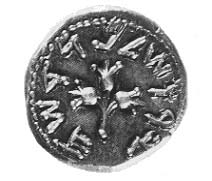Image Details

Jewish Museum/Art Resource, New York, NY
A nationalistic anachronism. Although the Jews who resumed from the Exile, beginning in 538 B.C., replaced their paleo-Hebrew script with the square-Hebrew script, the older script was revived for coin legends during the Jewish revolts against Rome and for other nationalistic purposes. On this silver half-shekel from year 1 (66 A.D.) of the First Jewish Revolt against Rome, for example, a paleo-Hebrew inscription surrounds a stem with three pomegranates, at center. Reading from the right, the letters spell yrwslm qdsh, “Holy Jerusalem.” As many as eight of the letters on this coin may also appear in the Bat Creek inscription. The ornamental dots at the ends of the lines that form the letters on the coin are called “pearls.” These devices, which are analogous to the serifs that often appear on Roman letters, imitate those used on Greek-language coins of the same period. Such pearls appear on two of the Bat Creek letters: the lamed and yod.
